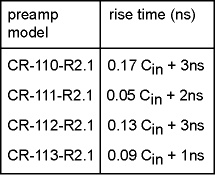There are a number of considerations and trade-offs to make when choosing the right charge sensitive preamplifier (CSP) for your application. This guide will help you make the best decision.
All of Cremat's preamplifier models are intended for use in radiation detection applications where the radiation is detected as a series of pulses. An example of this would be a gamma-ray spectrometer. In this case, the detection of each gamma-ray produces an electronic pulse that is amplified and measured. There are some radiation detection applications where this is not the case. For example, in CT imaging X-ray flux is detected as a continuously varying current, and the detectors are read by transimpedance amplifiers.
Cremat's preamplifier model having the highest gain and best noise performance is the CR-110, and for this reason it may be the best choice for many customers. There are a number of other considerations, however, which may lead the user to choose one of the three other preamplifier models. These considerations are listed below:
1) Maximum detectable pulse
In choosing a preamplifier for your application, it is often best to start by considering the model having the highest gain: the CR-110. A potential problem, however, is that the high gain of the CR-110 will cause large signal pulses (larger than approximately 107 electrons) to saturate the preamplifier circuitry. In these applications it is best to choose a less sensitive preamplifier. The gain, maximum detectable pulse magnitude, and noise level of Cremat's preamplifier models are listed here:

* @1μs shaping time, input unconnected
A good approach to selecting the right preamplifier is to choose the model having the largest gain which is also capable of detecting the largest pulses you expect to detect in your application.
If you are unsure about how to calculate the size of the pulses in your application, help may be found here: Pulse size calculation.
2) Rise-time performance
The rise time performance of Cremat's charge sensitive preamplifiers (CSPs) vary amongst the various models, as can be seen in the following table, where Cin is the capacitance (in pF) at the preamplifier input:

Keep in mind that in some detectors, rise time will be limited by the detector itself. In these cases the use of a faster preamplifier will not improve the situation. In applications with fast detectors, however, you may wish to choose your preamplifier with these preamplifier rise time specifications taken into consideration.
3) High count rate
In high count rate applications, the preamplifier circuitry can sometimes saturate due to the high rate of detector current being sourced or sunk at the preamplifier input. In these high-rate applications, you may wish to avoid the high gain preamplifier models (e.g. CR-110) which are the most prone to this saturation.
Calculating whether a particular preamplifier can process a certain count rate is complicated, because the answer depends on the distribution of pulse sizes being detected and the distribution of events over time (e.g. random over time, occurring only during certain time windows, etc). A somewhat simplified approach would be to assume that the pulses occur totally randomly over time and that the detected pulses are very many small pulses (rather than a few number of larger sized pulses).
If we assume that the preamplifiers are DC coupled to the detector, then we can treat the simplified detector current described above as a DC current passing into the preamplifier input. The maximum DC current that can be sourced or sunk by Cremat's preamplifiers before reaching saturation are given by the following table:

In this simplified case, the maximum count rate the preamplifier would be able to process would be that which produced a detector current equal to the maximum DC input current listed in the above table. Note that the high gain preamplifiers have the worst count rate processing ability. Also consider that our assumption that the detector current is comprised of many small pulses represents a best-case condition for the preamplifier maximum count rate.
If AC coupling is used between the detector and preamplifier, the count rate capability of the preamplifier is dramatically increased, at least if we use our simplifying assumption that the detector signal current is made of very many small pulses. Using AC coupling, the DC detector current no longer passes into the preamplifier input. As a result, the preamplifier output saturates only when the output fluctuations become so large that they exceed the rail-to-rail output range of the preamplifier. The size of these fluctuations depend on the size distribution and rate of the detected pulses, and it is difficult to quantitatively describe the count rate limitations of the preamplifiers under these conditions. It remains true, however, that the highest gain preamplifiers have the worst count rate processing ability and the lowest gain the best.